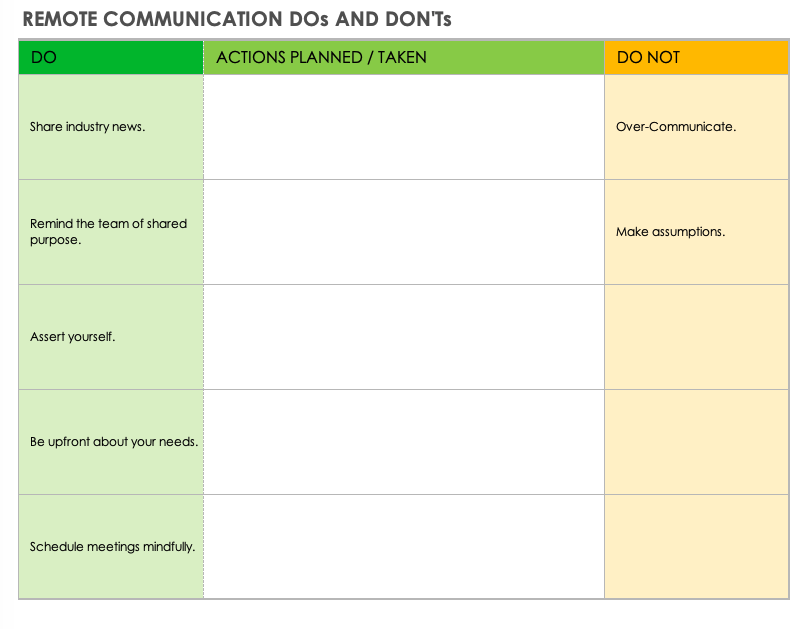Communication Methods for Remote Teams
Communicating with remote teams involves a variety of channels and tools, often including email, instant messaging (IM), videoconferencing, and other apps and software. To do so effectively, you also need to establish organizational communication norms around frequency, channel, and tone.
Remote teams use a combination of synchronous and asynchronous communication methods to collaborate. Synchronous communication refers to communication among multiple parties in real time (with immediate responses, similar to live conversation). Asynchronous communication is non-real-time communication, with intermittent responses. It’s important to find the right balance between the two and to develop an instinct for which style is most appropriate for your work needs at any given time.
What Is Asynchronous Communication?
Any communication that doesn’t require a real-time response can be considered asynchronous, including email, message boards, dashboards, and more. This type of communication is good for company or team announcements, larger project or product planning discussions, and some feedback, but less ideal for messages that need quick answers or a more nuanced conversation.
With asynchronous communication, you aren’t constantly interrupted by messages that need an immediate response. Remote team members can disconnect and focus on work and take the time to think before answering. Additionally, asynchronous communication provides a written record of information and decisions. You can also include all involved parties, regardless of differences in time zones or personal schedules. However, it’s important that organizations set standard work hours and don’t pressure team members to respond outside of them.
To get the most out of your asynchronous communication, set expectations around response time, and be thoughtful when planning real-time meetings (days of the week, time zones, etc.). Additionally, clearly and adequately contextualize your needs — whether by supplementing with images and screenshots or referencing related conversations and documentation — to avoid inviting a wave of unnecessary and messy follow-up questions.
For an overview of how you can incorporate tools to support asynchronous communication, see the section on tools for remote communication below.
What Is Synchronous Communication?
Synchronous communication is any communication that happens in real time, thereby allowing for immediate responses. Traditionally, this type of communication occurs in person at workplaces. Think: meetings, popping into a colleague’s office, spontaneous brainstorming, and even catching up socially. More formal examples include company retreats, performance reviews, or monthly one-on-one check-ins. Synchronous communication is great for socializing and team building, as well as for efficiency when you need a quick answer. (For ideas on team-building activities, read “56 Fun, Easy, and Effective Team Building Exercises for Remote Teams.”)
In remote settings, you often have to get creative to support synchronous communication. Video meetings and chat are the most common approaches. You can also host live virtual social events, such as a dance party or a game, to encourage your team to socialize. You should plan this type of communication, and use it respectfully; it is more draining to converse via a screen than it is in person. Also, have a plan in place for emergency situations when these methods of synchronous communication may not be available.
Of course, you’ll need to find a balance between asynchronous and synchronous approaches, so that you can effectively communicate without overwhelming your team.
Sergey Konoplich, COO at Smart IT, offers his experience. “Working with clients in different time zones has always meant that we relied on a healthy mix of both [approaches],” he says. “Since we are all based in one country, we can definitely take advantage of communicating in real time via [the] company Slack or Telegram chats.”
Regardless of what apps you use, establish norms around communicating with your remote team, so people know what to expect. While these guidelines will vary depending on your industry and company culture, the following chart provides a general overview of when to use asynchronous vs. synchronous communication methods. (Keep in mind that this suggestion is intended for remote teams; you may delineate communication styles differently in an office setting.)
“From the beginning, define the guidelines regarding how a team will function, especially when distributed across time zones,” says Bryant Galindo, Founder of CollabsHQ and a mediator, consultant, and trainer who works with large-scale organizations and startups. “[This] gets everyone on the same page. You want to be clear on whether team members will be working off-hours, who will be doing what, and what technology supports [the] team and project management.”
That said, Konoplich warns against over-regulating communication and supports letting employees retain a sense of autonomy. “We have decided against regulating response times and have generally seen very diligent behavior from team members. If you don’t over-regulate, it tends to work out for you in the long run,” he says.
How to Communicate with a Remote Team
To communicate effectively with a remote team, hold regular meetings, invest in tools to support communication, and create additional opportunities for team members to connect in the absence of in-person interaction.
To learn more about transitioning to remote team work, read “Digital Nomads: Setting a Course for Success in Today’s Workforce.”
In addition to creating guidelines for when to communicate, institute norms for when to use each communication channel (email thread, IM, video call, etc.). You can even create acronyms for recommended response types if that helps your team to follow processes. Below are general tips on using the different forms:
- Email Threads: In a remote work context, email is best for formal announcements and high-level communication (often to the larger team), but not for issues that require a lot of back and forth. “We generally reserve email threads for official announcements and events,” says Smart IT’s Konoplich.
Galindo adds that email can serve as a system of documentation and work “receipts.” He says, “Use email threads for creating paper trails, establishing who is doing what and when, and [for] any feedback that needs to be written down.” - Instant Messaging/Chat: IM is a great stand-in for light or informal in-person conversation, one-on-one needs, or any issues requiring a quick, fast resolution. “IM is useful for immediately getting someone’s attention on something or to ping a person on their availability for an urgent matter,” says Galindo.
The way you use chat can be a bit more informal than your approach to other, less casual forms. Konoplich explains that at Smart IT, for instance, they “prefer to discuss things in IMs as they come.”
Chris Gadek, Head of Growth and Marketing at AdQuick, says that chat is sometimes preferable to other, less lightweight communication tools. “While there are a plethora of project management apps, sometimes a quick message can get you back to work faster,” he shares. “Use your favorite social messenger, but also incorporate easy integration [with] other apps.” That said, be wary of being too casual on chat — remember that it is still a work space, so keep personal conversations separate. - Telephone or Audio-Only Calls: While less common today, voice calls are still a good synchronous communication option for remote teams — but don’t rely on them. “We reserve voice calls for any impromptu discussions,” explains Konoplich. “Since we also work with a generally younger workforce, it’s crucial not to threaten the younger generations with voice calls, as they prefer messaging instead.”
- Video Calls: In longer-term remote work situations, video calls often replace standard in-person meetings, as well as performance reviews or in-depth project development sessions. Galindo offers the following advice: “Use a video call (preferably with your video camera on) when you need to give feedback, have a performance conversation, or brainstorm in real time.”
But Konoplich notes that there can be some privacy concerns with video calls. “With people working from home, we tend to avoid video calls, unless they are recreational,” he says. “It’s best not to infringe on personal spaces, [as] people might not want you peeking into their homes.” To combat this, some videoconferencing tools, like Zoom, allow you to select a preset background.
While not a hard-and-fast set of rules, the below infographic can guide you in writing your own guidelines for when to employ certain types of communication methods.
Quick-Action Guide for Transitioning to Managing a Remote Team
Adhering to the general methods outlined above will help you streamline remote communication, but transitioning to managing a remote team — especially when you have to do so unexpectedly — is difficult. To ease the transition, we’ve winnowed down high-level expert advice into five easy steps:
- Establish Documentation Practices: Take time to evaluate current documentation practices and update them to better suit the conditions of remote work. It’s okay to slow or pause certain workflows during this time — until you put in place new processes, your work won’t be effective anyway.
- Set Clear Policies and Expectations: In addition to reevaluating goals and deliverables, set (and share) policies around communicating remotely, so everyone knows what is expected of them and can respect boundaries.
- Ensure Team Members Have the Right Tools and Equipment: All team members need to have the right systems, apps, and technical capabilities. Square this away before forging ahead with projects.
- Be Flexible with Extraneous Circumstances: Many people will face new and heightened stressors in the transition to remote work. Be conscious of these factors, and check in with your team to learn how you can better support them.
- Trust Employees: Resist the urge to micromanage your team. Trust that team members will continue to perform to the best of their ability. Focus on connecting with and supporting your team, rather than assuming the worst and stunting actual productivity.
Best Practices for Communicating with a Remote Team
Additionally, here are some tips for managers who need to communicate with a remote team:
- Be Proactive and Trust Your Hires: Communication is key to building rapport, trust, and respect — and helping a remote employee become a workhorse. Managers who conduct surprise check-ins may induce anxiety in their employees and be perceived as micromanagers. Those who pre-schedule a routine check-in or agree with the employee to work on a document sharing platform (where the manager can take a peek at progress) may fare better.
- Hold One-on-One Meetings with Remote Workers: To maximize a remote team member’s contributions, managers need to engage regularly and religiously with their off-site employees — especially if the worker is 100 percent off-site. One-to-one contact for semi-off-site employees can take the form of meals, coffees, or in-office meetings, but it’s important to maintain the relationship.
- Have Rock-Solid Communication Skills: Communication is key, and because communication is said to be 7 percent content and 93 percent nonverbal, managers working with remote teams will need to use voice, phone, video, and context-appropriate messaging to collaborate well with staff. Use emoticons and GIFs to show emotion and humor in virtual communications situations. Choose the right medium for the right message – important conversations happen live, use instant messaging for quickly resolvable queries, email can be a mix of quick-exchange messages, as can messaging systems that allow managers to prioritize tasks.
- Provide Technical Support: Remote team members still need access to IT and other technical support. Ensure your organization has a system in place for resolving equipment, software, and other technical issues, so employees feel supported — and you can get the most out of your communication efforts.
- Communicate about Process: Remote work requires even more clarity and precision around processes than traditional, co-located work. Not only do you need to build reliable, flexible, and straightforward workflow processes, you also need to communicate them — and any changes that arise — to the team. Share process updates early and often to avoid any work backlogs, unanswered questions, or unresolved issues.
Though you’ll establish general communication guidelines, keep in mind that you might need to make changes when issues arise.
“Knowing when to escalate communication comes down to a few things,” says Galindo. “First, if tone or context [is] easily misunderstood, then you’ll want to get on the phone or have a virtual call. And when the situation requires an urgent response, such as in the case of an emergency, you can up the priority of your communication.”
For an in-depth guide to managing a remote team, read “Ground Control to Major Tom: The Keys to Effectively Managing Remote Teams.”
How to Communicate Within a Remote Team
Being a good communicator as a remote team member (rather than a manager) is essential, and it often involves making an extra effort to socialize and connect outside of standard, work-related communication.
Here are five ways to amp up connections with your teammates when working remotely:
- Visit the Virtual Water Cooler: In place of in-person office run-ins and casual lunch or break room chat, encourage socialization around a virtual water cooler where team members can “hang out.” The space can be virtual, and as long as you aren’t violating any company security measures, it might even take place on social media.
“Instagram has been our best virtual water cooler,” says Konoplich. “We have devs and managers participating in daily challenges, which prompts discussions among team members and keeps people bonded.” - Hold Regular Check-Ins: This is a great way to help people feel connected from day to day, when morale might otherwise trend downward. Check-ins are less casual than water cooler chat, but still provide a relatively light way to ensure team members are doing okay.
Inna Shevchenko is the CMO at iGMS, a short-term rental management software company. When working remotely, she says, “We communicate constantly and make daily check-ins to support each other and keep the team spirit vibrant. Apart from this, we have a set of regular department and company meetings.”
But depending on the nature of your work, daily check-in calls may be overkill. Find a frequency that works for your team, and consider other tools at your disposal. - Host Group Brainstorm Sessions: Even if you aren’t in a creative industry, you can include employees in a larger group brainstorm to help shake up the monotony of siloed remote work, get the juices flowing, and keep the team motivated. “We hold brainstorms at all levels, both during the dedicated meetings or just in Slack,” says Shevchenko. To learn more about collaborating with remote teams, read “How to Maintain Strong Collaboration in a Remote Work Environment.”
- Update Task Boards and Monitor Team Progress: For work items that don’t require written or verbal communication, use task boards to keep the team on track and monitor goals. This tool can cut down on unnecessary synchronous communication and free up team members to actually work.
As Konoplich shares, “We haven't had to do daily check-ups, because we employ a task-tracking tool that calculates hours and progress. Anyone with the right clearance can see their team's progress on tasks and how long they are taking. Essentially, we can see weekly reports.” - Incorporate Fun into the Work Day: Even remote teams need to enjoy themselves to produce strong work. Konoplich encourages finding ways to build in pure social communication to boost morale.
“Smart IT has ramped up its effort to connect team members outside of work by relying on three tactics: video cookouts, weekly online video game tournaments, and engaging Instagram challenges,” he explains. “These have been employed not only for team building, but also for stress relief and improving team spirit.”
To learn more about building a strong remote team culture, read “How to Create a Strong Remote Company Culture that Drives Success.”
Remote Communication Style Dos and Don’ts
As a member of a remote team, you’ll have slightly different responsibilities than you would as an employee on a co-located team. To shine as a team player, try the following:
- Share Industry News: Demonstrate a commitment to your team’s vision and an awareness of industry happenings.
- Remind the Team of Shared Purpose: This may not always be appropriate (in some teams, this is the manager’s role), but it can help with overall productivity when morale drags.
- Assert Yourself: Even as a remote employee, you have opportunities to take on additional responsibility or even be promoted. Step up just as you would in an office.
- Be Upfront about Your Needs: Productivity starts to break down when remote employees don’t ask for extra time to meet deadlines, take on too much work, or avoid necessary communication channels. Be upfront so your manager can appropriately delegate work (and keep a pulse on the team workload). Make sure to build in blocks of uninterrupted time to focus on larger projects or deliverables.
- Schedule Meetings Mindfully: When setting up remote meetings, especially video calls, limit the number of participants and assign talking points beforehand to streamline the meeting. However, you should retain an open-door policy for non-private meetings — just as you might in an office setting — so that people who want to be involved can take part. If circumstances allow for intermittent face-to-face meetings, schedule them in advance. Additionally, take time zones into consideration when your team is geographically dispersed. Learn more about working across different time zones by reading our guide to distributed software development.
Calloway Cook is the President of Illuminate Labs, a dietary supplements company based in Massachusetts. “Business leaders need to be cognizant of how their remote employees are affected by time zones when scheduling meetings,” he says. “If you always schedule team calls at 9 a.m. EST and have employees working on the West Coast, you're seriously inconveniencing those employees relative to East Coast employees, which isn't fair and leads to lower team morale. We have a team distributed across the United States. I try to schedule meetings during midday, so it doesn't negatively interfere with anyone's schedule.”
On the flipside, experts recommend that you avoid the following:
- Over-Communicate: While remote work requires an additional level of communication, don’t inundate your colleagues with messages and information. This goes for managers, too, who are at risk of micromanaging and over-regulating remote communication.
As Konoplich advises, “Not everyone is accustomed to remote work. Don't add extra pressure to it by over-regulating. The transition [to remote work] should be seamless, and employees need to find their rhythm with time. To preserve the pace of progress, maintain a presence in your company's main communication channels and preserve team bonding activities. They help weather the storm and set the mood for productive work.” - Make Assumptions: The lack of in-person connection can handicap communication efforts, since you lose body language and other nonverbal signifiers. Make the most of written (or other virtual) communication, and always ask — rather than assume — when you need clarification.
Remote Communications Dos and Don’ts Chart
Communication Issues with a Remote Team
Remote work often surfaces communication issues that might not arise in a traditional office, including disconnected team members, loneliness, or redundancy. As remote work remains on the rise, it’s important to mitigate those issues with creative solutions.
Owl Labs State of Remote Work 2019 survey reported that, among employees who currently have a remote work option, 42 percent plan to work remotely more often in the coming five years. While the increased availability of cloud-based tools, videoconferencing, and other technologies ease the escalation of remote work, teams should also take “soft,” people-centered approaches to keeping team members connected.
The following often prove difficult in remote work settings:
- Building Relationships: When working remotely, you often lack emotional context or tone indicators that could otherwise help colleagues form bonds. To help build trust (and foster light-hearted conversations), encourage social communication in meetings, rather than only work-related talk. The latter can feel stilted and doesn’t follow normal conversational flow.
- Strategizing: For long-term or complex projects, it can be difficult to foster creative, generative planning sessions from a video call. Freeform brainstorming or association exercises can help get the juices flowing.
- Resolving Complex Problems or Issues: This goes for situational and technological issues. In fact, a 2020 study by GetApp on the impact of new technologies on remote culture showed that less than half of remote employees report receiving proper internet security training. As mentioned, ensure you have the necessary support to resolve security or IT issues, and equip your remote employees with the resources to do so.
- Staying Updated on Projects: According to CoSo Cloud’s 2015 Remote Collaborative Worker Survey, more than half of remote employees say they feel disconnected from in-office employees. This finding affects not just interpersonal relationships, but also awareness of project status. Regularly scheduled meetings can alleviate this tension, but you can also employ project or task management tools that provide visibility into work in real time, so everyone stays up to date.
But the biggest overall threat to remote work is simple miscommunication. In fact, one in four remote workers are concerned that their off-site status can lead to miscommunications with leadership or teammates. Whether misunderstanding one another’s email tone or the priority level of a project or deadline, or just losing out on the nonverbal cues that grow out of sharing physical space with one another and waving across cubes now and again, remote team members are aware that they’re “not there” in some key ways.
To ward off any problems between manager and employee, both parties need to establish how they like to communicate. Scheduling regular periodic contact (a one-to-one call or video chat) can keep communication flowing and ward off potential misunderstandings. Additionally, managers and employees can use the email signature or other online status functions to alert colleagues of office hours or temporarily adjusted office hours, vacation dates, or other key information to set expectations about how quickly they’ll hear back. While messaging app emoticons may seem juvenile, in some workplaces managers use them to convey friendliness and levity in communications.
Communication Challenges for Remote Team Management
Those who manage a remote team face a distinct set of challenges, including instilling the feeling of a traditional on-site team. You can greatly improve morale and productivity by maintaining transparency, reducing affinity distance with video calls, and keeping lines of communication open.
Smart IT’s Konoplich says of remote work, “Morale falls to a minimum and people aren’t as proactive to be a part of a community. It’s up to the employer to set the stage for a seamless transition.”
Additionally, here are some ways to overcome common managerial communication challenges:
- Identify good work and find ways to celebrate successes with the team, even remotely.
- In addition to communicating respectfully across time zones, be mindful of language or cultural barriers and be proactive in reaching different communities.
- Foster creative synergy by including the team in brainstorming and strategizing (as appropriate), as well as allowing for social time in meetings.
- Practice strong, intuitive communication skills yourself — both as a model to team members and to form relationships with them. Know when to reach out, when to close off a conversation, who to include, and when to include them.
- Resist the urge to micromanage or make assumptions about your employees. Galindo explains that managers often “[think] that without seeing someone physically, that means they are not producing work.” He notes that “trying to micromanage in a virtual environment” is a common challenge with remote managers.
- Make sure you are well-trained on team tools. Galindo cites “the comfort of managers and team members when it comes to the use of technology” as a key indicator of larger success.
- Go above and beyond with onboarding to ensure that new hires who join the team remotely are adequately trained and feel welcomed.
- Schedule team and company retreats to get everyone together in the same physical space.
Ultimately, AdQuick’s Gadek says, “Managing a remote team can be both challenging and rewarding. In many ways, it can offer boundless innovation and a freedom that just can't be experienced in a traditional setting, while leaders must find creative solutions to hurdles that are unique to a remote culture.”
Tools for Remote Team Communication
As discussed, tools are essential for building strong remote communication norms and, therefore, vital to success. Most experts agree that the following, in some form, are essential:
- Calendar tools
- Cloud collaboration software
- Email and chat (or other messaging apps that drive communication)
- Project management tools (apps to organize shared projects, assign tasks, set deadlines, etc.)
- Videoconferencing
- Virtual hub (for company announcements, feedback, and a virtual “water cooler”)
With so many tools available, it can be difficult to identify the ones that best fit your needs. But Galindo emphasizes that taking the time to do so will help you in the long run, even if it requires some trial and error.
“Just as you had to learn how someone works in real life, finding the right piece of software that works best for your team and its intended goals is a process of experimentation,” he shares.
For an in-depth discussion of the top remote communication and collaboration tools, and how to find the tools that best fit your needs, read “Discover the Remote Collaboration Tools to Fit Your Business Needs.”
Remain Effective while Working Remotely with Real-Time Work Management in Smartsheet
Empower your people to go above and beyond with a flexible platform designed to match the needs of your team — and adapt as those needs change.
The Smartsheet platform makes it easy to plan, capture, manage, and report on work from anywhere, helping your team be more effective and get more done. Report on key metrics and get real-time visibility into work as it happens with roll-up reports, dashboards, and automated workflows built to keep your team connected and informed.
When teams have clarity into the work getting done, there’s no telling how much more they can accomplish in the same amount of time. Try Smartsheet for free, today.





